
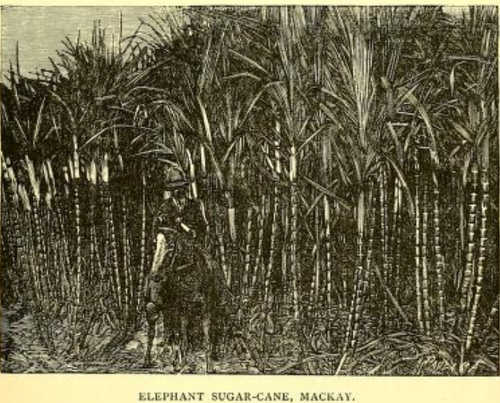
Journey to Northern Queensland - Mackay-sugar - Employment of South Sea Islanders - Townsville - A rough northern man - Sugar district in Lower Herbert - Visit to a successful Scandinavian - Blacks near Gardiner's farm - Nulla-nulla - Spring - Arrival at Herbert Vale.
In May 1882 I was at length able to set out on my journey to Northern Queensland. Early one morning at four o'clock I arrived by the steamer at Mackay, where I put up at the city hotel. Everything was open; there was nobody to receive you, nor would anybody get up for the purpose. I had to look for my room myself, and at last I succeeded in finding one.
Mackay is a small town, owing its existence to the production of sugar, and the vicinity, celebrated for its fertility, is at the present time the most important sugar-producing district of the colony. Queensland has been found to be upon the whole especially adapted to the cultivation of the sugar-cane, and the colonists have learned how to overcome all the disadvantages of the climate, so that the sugar-cane is raised not only in the tropical regions in the north, but also as far south as the vicinity of Brisbane.
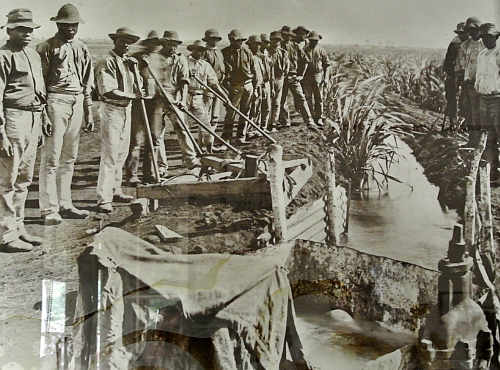
The work on these plantations has in a great measure been done by the natives of the South Sea Islands, who in Australia are called Kanakas - a capable and intelligent race, especially suited to this kind of work, for they are strong, and endure the tropical heat far better than the whites. They contract to stay three years, and are paid £18, and get a free passage both ways. As a rule they are well treated on the plantations, and it frequently happens that they settle in the land. They are well liked, because they are willing to work; but they are hated by the white workmen, who look upon them as competitors. Many abuses have crept in through the introduction of the Kanakas, and the Government, earnestly supported by the white working men, has to a great extent prohibited their importation. The result is that it has become necessary to limit the cultivation of sugar in many places, which is very unfortunate, for the Queensland sugar is strong and of an excellent quality. There is an abundance of fertile lands, so that the production of sugar must in time become one of the most important industries of the colony.
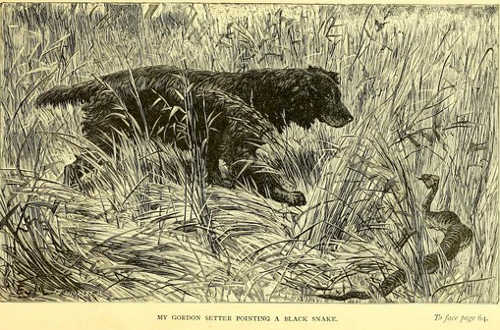
During my sojourn in Mackay my dog, a fine Gordon setter, was exposed to great danger at a station near the town. She suddenly stopped in the high grass, and as I cautiously drew near I discovered in front of her a splendid specimen of the black snake (Pseudechis), whose head had assumed the flat form which is peculiar to venomous snakes when they become excited. The hot weather had made it still more angry. With the head slightly raised from the ground, it lay just ready to give my dog a fatal bite if the latter made the slightest motion. I hastily called the dog back, broke off a branch from a tree, and killed the treacherous enemy, the most venomous snake of Australia. It was glistening black with a reddish belly, and longer than myself when I held it up.

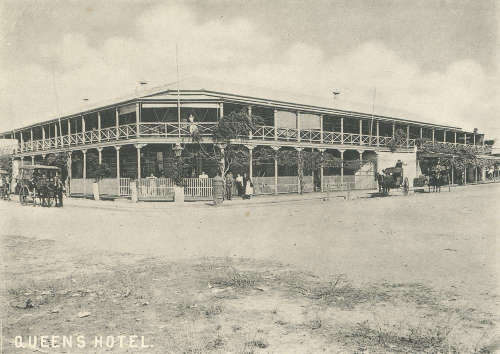

In July I embarked in a coasting steamer which was to take me farther north, and after a journey of two days we reached Townsville. The steam-launch met us out in the bay in order to bring us ashore, for the harbour is so shallow that large ships cannot lie alongside the wharf Townsville is situated on Cleveland Bay, partly along a little river and partly on the slope of a mountain which rises to the elevation of 900 feet above the town. The latter accordingly has a very fine situation. The locality now occupied by Townsville was first discovered in 1864. The town is growing so rapidly that it is already regarded as the chief metropolis of Northern Queensland, and there is no doubt that it will take the first rank when this part of Queensland is divided from the south as a separate colony.
The value of land in this city, which now contains about 7000 inhabitants, has risen so enormously that it borders on the phenomenal, even in a newly settled land like this. Thus it has not infrequently happened that a lot in the course of two or three years has doubled in value several times.
Townsville is the terminal station of the northern railway, and were it not for the shallow harbour it might safely be predicted that it would become one of the principal cities of Australia, both on account of its extensive shipping and of the rich soil of the interior. The chief industry in the vicinity is cattle and sheep raising, and wool is the principal article of export. Nor is the town without importance in relation to the rich gold beds at Charters Towers. As Townsville has an agreeable climate, the squatters in the arid west are accustomed to come to the comfortable Queen's Hotel, which is situated by the seaside, in order to seek recreation after all their hard work and privations. I also put up at the Queen's, which in spite of its northern situation is undoubtedly the best hotel in Queensland; but this is, after all, not saying very much in its favour.
My destination was Herbert Vale, a deserted cattle station on Herbert river. My first intention was to get there by way of Cardwell, a little coast town north of the mouth of Herbert river, from which the distance to Herbert Vale would be only twenty miles, while from Dungeness, which is situated at the mouth, it was at least forty miles up the river.
Meanwhile I learned that there were many obstacles in the way of reaching Herbert Vale from Cardwell. On the other hand, I was strongly advised to go to Dungeness and thence up the river by boat to some sugar plantations, where I should have more chance of obtaining the necessary horses than at Cardwell. Besides, I had a letter of introduction to one of the largest plantation -owners there, and knowing from experience how valuable such an introduction might be in uncivilised districts, I decided to go by way of Dungeness.
In the afternoon, one or two hours before the departure of the little coast steamer, I went down to the captain to buy a ticket for Dungeness. All my baggage had already been sent on board marked "Cardwell." I requested the captain to look after it and have it sent ashore, and showed him where it stood. But no sooner did he see that it was marked "Cardwell" than he began to insist that I was obliged to go to Cardwell. In vain did I strive to maintain my right to go where I pleased. The captain insisted that I must go to Cardwell, and not to Dungeness. He was one of those rough fellows whom we occasionally meet on the borders of civilisation, and it was the first time that I made the acquaintance of a specimen of that amiable race of Northern Queensland - the rough northern men, as they are called.
I of course realised that every argument was superfluous; and therefore made no objections, thinking matters would right themselves in due time. The captain went down into his cabin, and I was on the point of going ashore, wondering how so small and modest a boat really could contain so mighty a man, when my eyes fell upon one of the crew, who looked more accommodating than the others. I told him who I was, and that I was bound for Herbert Vale, where I was to collect specimens of natural history for the Christiania University. In proof of my statement I pointed to my red painted spirit cans which were marked, "University of Christiania, Norway."
"Why, are you Norwegian?" asked he with the usual coolness of a sailor; "I am also from Christiania, and the captain yonder is from Horten," he added, in a genuine, broad Christiania dialect, pointing to a little steam-ferry which lay moored by our side. I expressed my surprise at meeting Norwegians so far up in the tropical north, and in the name of our common country I asked him to help me. He had heard my loud conversation with the captain, and exclaiming in a very disrespectful tone that what the captain had said was a matter of no moment, he at once began to have my baggage properly placed for my destination, Dungeness. In the evening we weighed anchor and started for the north. The captain came on deck intoxicated, as we were about to start, and so the crew took command. The next day we arrived safely at Dungeness at the mouth of Herbert river.
Hinchinbrook Island, a rocky isle rising to an elevation of about 2,500 feet above the level of the sea and nearly always enveloped in fog, attracts the attention of the traveller. The few white people who heretofore have visited it were cedar-cutters. The valuable red cedar (Cedrela) grows in the dense scrubs along the rivers in Northern Queensland, and the timber is floated down the streams in the rainy season. Unlike the Australian spruce, which soon decays, the cedar log may lie a whole year in the woods before it is floated. The wood is as beautiful as mahogany, but not quite so firm and solid. It has been in such great demand that whole forests have been entirely exterminated in the most accessible places; it is the only wood exported from Queensland.
I at once proceeded in a boat up the river, whose banks for several miles are covered with mangrove forests. The landscape gradually widens into a broad and flat valley, with excellent sugar land, which is now thoroughly cultivated; a steam-plough even having recently been brought here. I was well received, but wholly failed to obtain horses, as I had expected. There was none to be hired, nor could any be purchased; hardly a saddle could be procured in this comparatively uncivilised district.
One day I went down to the mangrove swamps to shoot a small gray heron, which I had seen on my arrival. On my way back I passed a farm, which belonged to a countryman of mine. Fastening my boat to the river bank, I went ashore to pay him a visit. The place gave me the impression of wealth and comfort. A corn-field extended up to the house, and on the verandah was a large heap of corn-husks. The farmer was married to a Norwegian woman, but both had nearly forgotten their mother tongue. They had several children, and the whole family, having been afflicted with the malarial fever, looked pale; yet they were well and happy. The husband had begun life in Australia as a carpenter on the first sugar plantation in the district.
Mechanics are usually the most successful among Australian immigrants. Here, where the climate was unhealthy, they were especially well paid. He therefore accumulated a considerable sum of money in a short time, and bought land. Fortunately for him his property soon rose in value, for the land along the whole river proved to be excellent for sugar- growing. A large plantation was established farther up the stream, and there being a good harbour on his property, he sold a piece of land for a large price, and was now worth about £10,000. Ten years ago he came here penniless.
The banks of the river consist of rich soil, and on the higher ground are extensive plains covered with mighty gum- trees, which were continually being felled, while the ground was being ploughed for sugar-cane. Down by the river there are scrubs, the favourite of all farmers on account of the fertility of the soil, and they are more dense and thrive better than those in Mackay. The country is, upon the whole, decidedly tropical. A great part of these woods had been cleared, and large waving fields of sugar-cane with some patches of corn had taken their place. The cultivated fields were being extended with great industry, neither capital nor labour being spared, and it made me almost sad to see the field of the naturalist daily disappearing. The large flocks of pigeons had difficulty in finding the high quandong-trees, in which they are wont to light. The magnificent "weaver -birds" flew about homeless in large flocks, for the great trees in which the colony had their numerous nests were felled. The cassowary became more and more rare; still I could see its footprints in the sand. The only animal which was not disturbed by the restless work of man was the crocodile, which was not even affected by the traffic on the river. It frequently happens that both blacks and whites disappear, for the crocodile is no less bold in its own element than it is timid on land. Thus a Kanaka was one day standing near the plantation washing his clothes in the river. His companions suddenly shouted to him to warn him, but he thought they were making fun, for he was standing scarcely up to his knees in the water, and consequently gave no heed to the warning. The crocodile approached noiselessly, pulled the unhappy man out into the river, and the waves closed over them. Only a stream of blood indicated where he had disappeared.
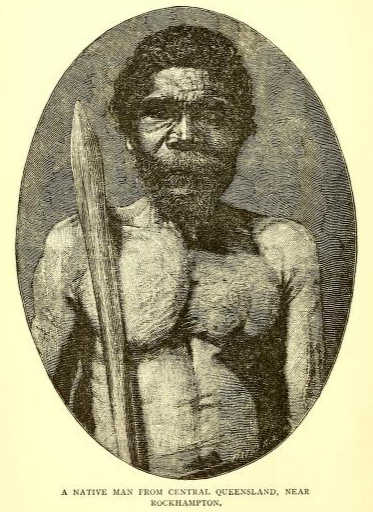

Having learned that a man who took an interest in natural history lived in the neighbourhood, I one day paid him a visit. His name was Gardiner, and he kindly invited me to stop at his house. Here I made my first acquaintance with the blacks of Northern Queensland. A large number of them, both men and women, all entirely naked, had their camp on his land.
The first thing which attracted my attention was Mr. Gardiner's treatment of these people. In the uncivilised districts the relations between the whites and the blacks are as bad as possible. In the remote districts the natives are treated almost like brutes. Still there are persons who take an interest in them (the "protectors of the blacks"), and Mr. Gardiner was one of them. He always had work for them on his farm, he furnished them with tools, and frequently went with them, cutting down trees, building fences, and the like. He had a remarkable faculty for getting the slow and lazy people to work, but he was certainly a great worker himself By way of salary he gave them large quantities of flour, sugar, and tea, and especially tobacco; when he killed cattle, he also gave them meat.
He not only abundantly supplied the men who worked, but also furnished the women with every necessity; in short, the whole camp lived at his expense. No wonder then that the blacks were fond of him ; they, however, did not forget their nomadic nature. Now and then they had to return to their native woods, but others would come in their places, so that Mr. Gardiner always had a camp of blacks on his farm.
They had gradually learned to make damper from their flour, and they made it as well as any white person. They prepared their own food in the camp, where they had cooking utensils which Mr. Gardiner had provided them with. They could be seen everywhere, even in the kitchen, where they always tried to keep on good terms with the cook, but they were not allowed to enter the sitting-room.
Mr. Gardiner liked to have these savages about him, still it was no easy matter to manage them. When he was with them, one would not think that he had much heart, for he addressed them in a harsh tone, and scolded them terribly when they had done anything wrong. If the camp became too unruly, he sometimes had to go out in the night and frighten them with a rifle shot. This was quite necessary in order to maintain discipline, though he was in reality goodness itself; he even protected their women against the white working men on the neighbouring plantation.
It cannot be denied that he was too liberal toward the blacks. They were quite spoiled, and did not appreciate his disinterestedness; the result was that they became bold and aggressive. He told me himself that they would steal from him whenever they got a chance, and everything had to be kept under lock and key; he could never let the axes and knives which they used lie out of doors, and once a black man even broke in and stole. That, however, was an uncommon occurrence.
Upon the whole their civilisation was of a rather low order. Eleven days before my arrival they had killed and eaten a man of another tribe on some hills near the farm. They returned triumphant, and boasted of their inhuman act. When they were abused for having eaten a man, they gradually became silent, and understood that it was something which the whites did not do and which accordingly was not right. This is always the habit of the Australian natives: as long as they remain in their native condition they make no secret of their cannibalism, but continued intercourse with the whites teaches them to regard it as something which is not comme il faut. Yet they keep up this infamous custom in secret before abandoning it altogether.
I was continually with the natives, both during the day and in the evening, hunting animals, and I was very much amused by the companionship of these children of nature. The blacks of Herbert river gave me from the very beginning an increased interest in the Australian race.
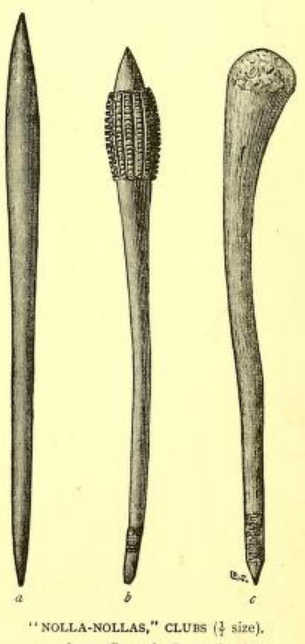
The boomerang was rare in these regions, for in the large scrubs there is no use for it. On the other hand I frequently saw another weapon, the "nulla-nulla" or club, the warlike weapon of the Australian native most commonly in use. It is a piece of hard and heavy wood sharpened to a point at both ends. One end is thick, and tapers gradually to the other end, which is made rough in order to give the hand a more secure hold; in using the weapon the heavy end is thrown back before it is hurled.
No great pains are taken in the making of these clubs. The majority of them are about two feet long. At a distance of ten to twelve yards the native will hit an object with a tolerable degree of certainty, but only small animals can be killed with this weapon.
As a weapon for hunting, the club is also of great service in another way. The small end is used for digging up the ground and loosening it when the native wants to bring out bandicoots, rats, roots, and similar things. With it he searches for eggs in the remarkable mounds of the talegalla [scrub turkey]. With his nulla-nulla he pounds at the trees to learn whether they are sound, and picks out the larvae from the decayed trunks.
One day an egg of a cassowary was brought to me; this bird, although it is nearly akin to the ostrich and emu, does not, like the latter, frequent the open plains, but the thick brush-wood. The Australian cassowary is found in Northern Queensland, from Herbert River northwards, in all the large vine-scrubs on the banks of the rivers and on the high mountains of the coasts.
For some time I made daily visits to the river bank and caught the beautiful green and blue Orthoptera, which from ten to eleven o'clock in the morning were found flitting among the trees and bushes.
In the vicinity of Mr. Gardiner's farm there were both coffee and tobacco plantations, where the plants thrived very well. According to the owner's idea, however, the proper varieties had not yet been found. He had a tobacco factory near the plantation, but the tobacco produced here was so inferior in quality that the more fastidious even of the blacks disdained it. Tobacco thrives very well everywhere in Northern Queensland, and like cinchona, quinine, arrowroot, rice, and cotton, which wherever planted have thrived well, its cultivation is doubtless destined to become an important industry. It is only necessary to find the variety adapted to the climate. It requires great care, and the owner told me that he was obliged to look after every plant daily.
Although my visit to Mr, Gardiner's farm was both interesting and agreeable, I longed to get to my destination. Originally I intended to go there on foot and get some of the blacks to carry my baggage, but Mr. Gardiner surprised me one day by offering me an old horse (Kassik) which he had kept in pasture for a year and a half on the other side of the river. I was permitted to keep him as a pack-horse as long as I pleased. He likewise placed a saddle-horse at my disposal for a limited time. I felt very grateful for this liberal offer, which I accepted with pleasure, as it would relieve me from many difficulties.
Cheerful and happy, I started on my journey in beautiful, sunny spring weather, following the river upwards. All about, me was fresh and green. Light green patches of grass and thriving vine-scrubs, by the side of brooks and streams, which crossed my path on their course down to the river, passed in pleasing succession. The dark green vine-scrubs which, extended along the banks on both sides of the river gave the landscape its most conspicuous character, and contrasted well with the light green spots. The bottom of the valley was flat and fertile. Before me I saw continually the scrub-clad hills, the foot of which I knew to be my destination. It was on these mountains that I based so many hopes. It is true that Mr. Scott, the owner of this deserted cattle station, which he had kindly invited me to use as my headquarters, had warned me that I was coming to a poor place, where I must renounce every comfort. I was well aware of this, but was prepared to submit to various kinds of privation if I could but get the opportunity of living amid this instructive Nature, where I anticipated such great results. It was impossible to be melancholy in the midst of such wonderful surroundings ! All was bright and inspiring.
On the evening of the second day, as I was approaching Herbert Vale, I constantly heard a peculiar whistling sound in the grass, which I could not comprehend. On dismounting, I found that it came from an infinite number of small grasshoppers which were not yet fully developed. They retreated before my horses, and were so numerous that the blades of grass literally bent under their weight. Herbert river is sometimes visited by vast swarms of grasshoppers, which do considerable damage to the young sugar-cane.
Darkness set in, but I continued to ride three-quarters of an hour after sunset. Several times I was obliged to dismount in order to look for the direction of the path. When at length I could no longer find my way in the darkness of the night, I suddenly scented smoke, and after going a few steps in that direction I discovered that the grass had been recently burnt. Far away, the stumps of trees still shone with fresh embers. Fortunately I came across a camp of blacks near the river's bank. To the great terror of the natives I entered their camp, but quieted them immediately by showing them tobacco, for two pieces of which currency I induced one of them to be my guide to Herbert Vale.